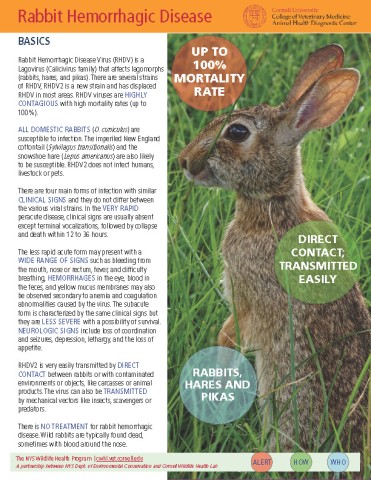USGS National Wildlife Health Center Update - August 31, 2020
An Update on National Wildlife Health Center Support to Wildlife Managers and Response to Rabbit Hemorrhagic Disease Virus 2
A large-scale outbreak of rabbit hemorrhagic disease (RHD), caused by rabbit hemorrhagic disease virus 2 (RHDV2), began in the spring of 2020 in the southwestern United States and adjacent northwestern Mexico. Categorized by the U.S. Department of Agriculture (USDA) as both a Foreign Animal Disease (FAD) and a Notifiable Lagomorph Disease in the National List of Reportable Animal Diseases (NLRAD), diagnostic testing for RHDV2 was initially limited to the USDA Foreign Animal Disease Diagnostic Laboratory (FADDL) on Plum Island, New York. Recently, USDA determined that RHDV2 outbreaks in some southwestern states and Washington state have reached “stable” status and has consequently disseminated virology testing procedures for RHDV2 to be conducted in additional laboratories. Specifically, the USGS National Wildlife Health Center (NWHC) and the Southeastern Cooperative Wildlife Disease Study (SCWDS) have been designated as primary laboratories for testing wild rabbits for RHDV2 in support of state, federal, and tribal wildlife management agencies.
We are issuing this update on RHDV2 to clarify the NWHC goals for providing technical assistance to partner agencies, issue NWHC submission guidelines for RHDV2 and the lagomorph surveillance guidance developed by NWHC, and provide an update on research activities.
Disease Status
As of August 2020, RHDV2 has been confirmed in black-tailed jackrabbits (Lepus californicus), antelope jackrabbits (Lepus alleni), desert cottontails (Sylvilagus audubonii), and mountain cottontails (Sylvilagus nuttallii) in the states of Arizona, California, Colorado, Nevada, New Mexico, Texas, and Utah. For up-to-date, national-scale information on the location, number, and species affected by the on-going RHDV2 event in wild lagomorphs, please visit the Wildlife Health Information Sharing Partnership-event reporting system (WHISPers). By creating an account in WHISPers, agency partners can utilize WHISPers to collaborate on disease events, request diagnostic and technical assistance from NWHC in response to disease events, and receive notifications regarding disease events of interest.
Links to full USGS Report update, survey methodology, and submission guidelines.
Additional sources of information on RHDV2:
AVMA - Rabbit hemorrhagic disease: Understand and prevent it (new)
United States Dept of Agriculture - RHDV Fact Sheet
USGS National Wildlife Health Center - Wildlife Health Bulletin 2020-05
The House Rabbit Society has an excellent web page on RHDV2
Rabbit Hemorrhagic Disease Virus 2 (RHDV2) information for wildlife rehabilitators and guidelines for surveillance and minimizing transmission
There is currently a large scale outbreak of RHDV2 in domestic and wild rabbits in New Mexico, Arizona, Texas, Colorado, and Nevada, wild rabbits in California, and an isolated case in domestic rabbits in New York City in 2020. We are very concerned that RHDV2 will spread more widely to NY (likely through the movement of domestic rabbits and parts) and infect our wild eastern cottontails and endangered New England cottontail rabbits. Please read on for more information and report in if you see any unusual mortalities in wild or domestic rabbits in your area.
Rabbit Hemorrhagic Disease Virus 2 (RHDV2) is one of a group of caliciviruses that infect rabbits. They are extremely contagious and can have a high mortality rate in both domestic and wild rabbits. These viruses spread between live rabbits or contact with contaminated materials; RHDV2 can persist in rabbit carcasses, feces, urine, blood, litter, and on fur and clothing for extended periods of time over wide temperature ranges. It appears sporadically around North America; there were isolated cases of RHDV2 in domestic rabbits in Pennsylvania and Ohio in 2018, and cases in domestic and wild rabbits in British Columbia and Washington State in 2018- 2020.
Once RHDV2 gets into our wild rabbit populations it will be very difficult to manage or eliminate. RHDV2 can spread very quickly through populations- taking less than 2 years to spread across Australia to all states and territories in 2015-2016 (https://jvi.asm.org/content/92/2/e01374-17 ). According to USDA-APHIS analyses, the outbreak in the southwest U.S. is a different strain than the outbreak in the Pacific northwest and New York, which suggests at least two separate introductions. Experiments have shown that our eastern cottontail (Sylvilagus floridanus) is susceptible to infection and mortality.
Disease onset in individual rabbits is rapid, signs may include fever, lethargy, seizures, blood from the mouth or nose. Although RHDV2 is not known to infect people or pets, other rabbit diseases like tularemia are zoonotic so protect yourself from exposure when handling sick or dead rabbits by using latex gloves and avoiding aerosols.
- Do not rehabilitate wild rabbits if you keep or accept domestic rabbits. RHDV2 can be spread by handling infected rabbits, cages or bedding then later handling uninfected rabbits.
- RHDV2 is resistant to many common disinfectants, freshly prepared 10% household bleach solution is the most readily available disinfectant that is effective for inactivating RHDV2.
- Do not allow people who keep domestic rabbits to have any contact with your wild cottontail rabbits.
- Please report unusual rabbit mortalities to your DEC Regional wildlife staff or the Wildlife Health Unit (518-478-2203). Place carcasses in plastic bag and keep in a cool place as they may be necessary for testing.
Additional sources of information on RHDV2:
https://www.aphis.usda.gov/publications/animal_health/fs-rhdv2.pdf USDA RHDV Fact Sheet
https://prd-wret.s3.us-west2.amazonaws.com/assets/palladium/production/atoms/files/WHB%202020-5%20RHDV2%20update.pdf USGS NWHC Wildlife Health Bulletin 2020-05
https://rabbit.org/rhdv/ The House Rabbit Society has an excellent web page on RHDV2
For more information on RHDV2, please register for the US Fish and Wildlife Services upcoming webinar on RHDV2 scheduled for June 3, 2020.
Rabbit Hemorrhagic Disease Virus 2: An Emerging Threat to North American Wild Rabbits



